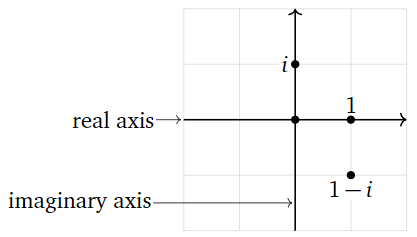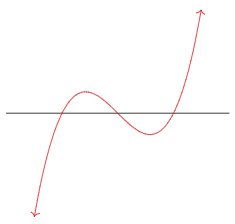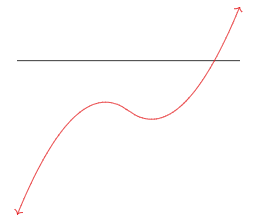7.1: A - Complex Numbers
( \newcommand{\kernel}{\mathrm{null}\,}\)
In this Appendix we give a brief review of the arithmetic and basic properties of the complex numbers.
As motivation, notice that the rotation matrix
A=(0−110)
has characteristic polynomial f(λ)=λ2+1. A zero of this function is a square root of −1. If we want this polynomial to have a root, then we have to use a larger number system: we need to declare by fiat that there exists a square root of −1.
- The imaginary number i is defined to satisfy the equation i2=−1.
- A complex number is a number of the form a+bi, where a,b are real numbers.
The set of all complex numbers is denoted C.
The real numbers are just the complex numbers of the form a+0i, so that R is contained in C.
We can identify C with R2 by a+bi⟷(ab). So when we draw a picture of C, we draw the plane:

Figure 7.1.1
We can perform all of the usual arithmetic operations on complex numbers: add, subtract, multiply, divide, absolute value. There is also an important new operation called complex conjugation.
- Addition is performed component-wise:
(a+bi)+(c+di)=(a+c)+(b+d)i.
- Multiplication is performed using distributivity and i2=−1:
(a+bi)(c+di)=ac+adi+bci+bdi2=(ac−bd)+(ad+bc)i.
- Complex conjugation replaces i with −i, and is denoted with a bar:
¯a+bi=a−bi. The number ¯a+bi is called the complex conjugate of a+bi. One checks that for any two complex numbers z,w, we have
¯z+w=¯z+¯wand¯zw=¯z⋅¯w. Also, (a+bi)(a−bi)=a2+b2, so zˉz is a nonnegative real number for any complex number z.
- The absolute value of a complex number z is the real number |z|=√z¯z:
|a+bi|=√a2+b2. One checks that |zw|=|z|⋅|w|.
- Division by a nonzero real number proceeds component-wise:
a+bic=ac+bci.
- Division by a nonzero complex number requires multiplying the numerator and denominator by the complex conjugate of the denominator:
zw=z¯ww¯w=z¯w|w|2. For example,
1+i1−i=(1+i)212+(−1)2=1+2i+i22=i.
- The real and imaginary parts of a complex number are
ℜ(a+bi)=aℑ(a+bi)=b.
The point of introducing complex numbers is to find roots of polynomials. It turns out that introducing i is sufficent to find the roots of any polynomial.
Every polynomial of degree n has exactly n (real and) complex roots, counted with multiplicity.
Equivalently, if f(x)=xn+an−1xn−1+⋯+a1x+a0 is a polynomial of degree n, then f factors as
f(x)=(x−λ1)(x−λ2)⋯(x−λn)
for (not necessarily distinct) complex numbers λ1,λ2,…,λn.
The quadratic formula gives the roots of a degree-2 polynomial, real or complex:
f(x)=x2+bx+c⟹x=−b±√b2−4c2.
For example, if f(x)=x2−√2x+1, then
x=√2±√−22=√22(1±i)=1±i√2.
Note that if b,c are real numbers, then the two roots are complex conjugates.
A complex number z is real if and only if z=ˉz. This leads to the following observation.
If f is a polynomial with real coefficients, and if λ is a complex root of f, then so is ¯λ:
0=¯f(λ)=¯λn+an−1λn−1+⋯+a1λ+a0=¯λn+an−1¯λn−1+⋯+a1¯λ+a0=f(¯λ).
Therefore, complex roots of real polynomials come in conjugate pairs.
A real cubic polynomial has either three real roots, or one real root and a conjugate pair of complex roots.
For example, f(x)=x3−x=x(x−1)(x+1) has three real roots; its graph looks like this:

Figure 7.1.2
On the other hand, the polynomial
g(x)=x3−5x2+x−5=(x−5)(x2+1)=(x−5)(x+i)(x−i)
has one real root at 5 and a conjugate pair of complex roots ±i. Its graph looks like this:

Figure 7.1.3



